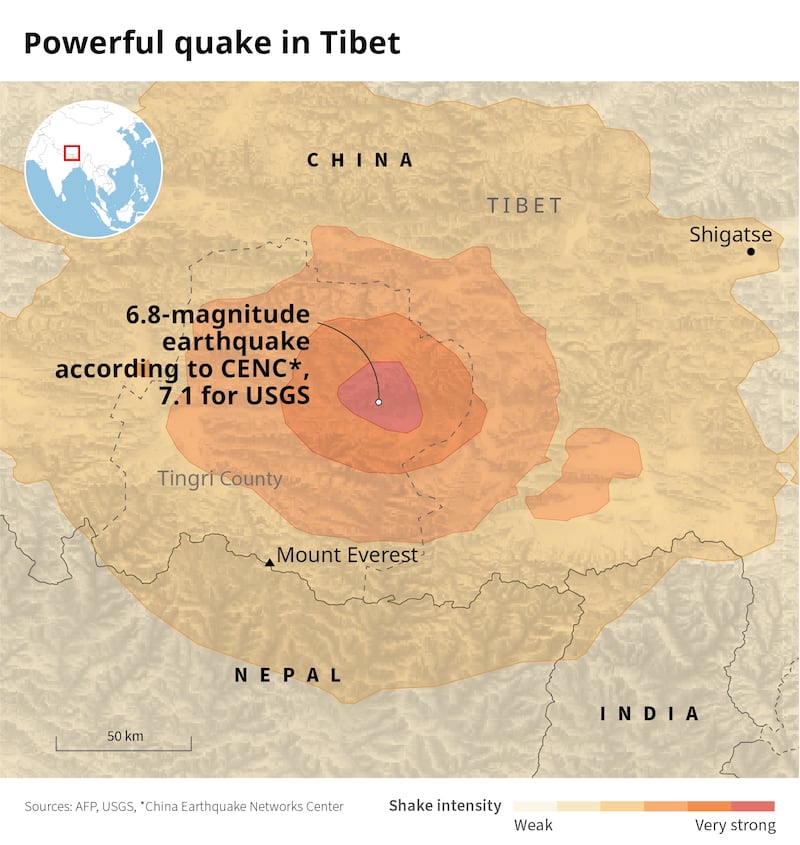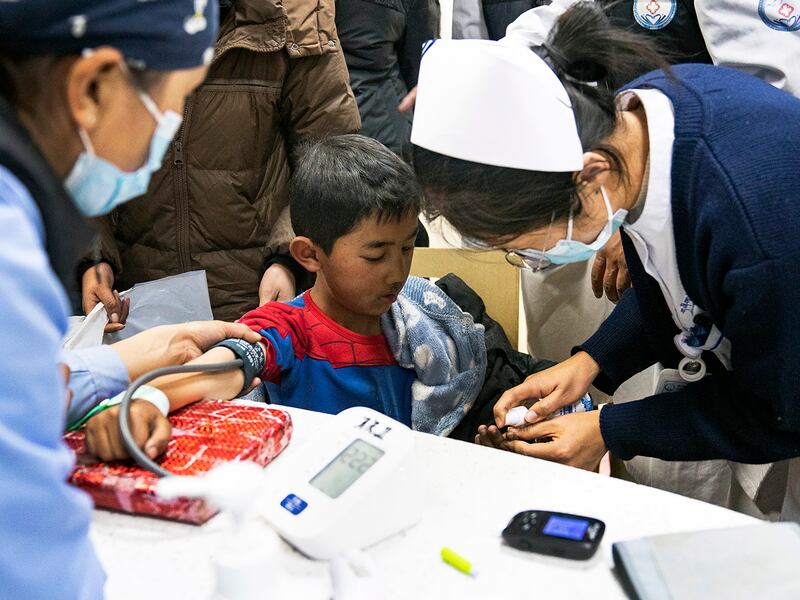Read RFA coverage of this story in Tibetan.
Chinese authorities on Wednesday said the death toll from the powerful earthquake that struck Tibet stood at 126, though sources in the region told Radio Free Asia that they estimate the actual numbers to be higher.
They also said Tibetans have been restricted from sharing information about the disaster outside Tibet.
On Tuesday, a 7.1-magnitude earthquake struck at 9:05 a.m. local time in Dingri county of Shigatse prefecture in the Tibet Autonomous Region — close to the border with Nepal — according to the U.S. Geological Survey.
Chinese authorities say at least 126 people were killed and 188 others injured. Over 3,600 houses were destroyed, with the tremors felt in neighboring India, Nepal, Bhutan and even in Bangladesh.

The focus of relief efforts in the earthquake-hit region — where January temperatures typically plunge to as low as minus-16 degrees Celsius (3 degrees Fahrenheit) — have now shifted from rescue and search to resettlement and reconstruction, local authorities said on Wednesday.
According to local authorities, roads, electricity and communications networks had been restored in Dingri and Lhatse counties by the afternoon on Jan. 8. In addition, around 187 resettlement sites had been set up, and 46,500 people had been resettled, they added.
Dingri county has a population of about 60,000, according to a 2020 census.
“We have been strictly instructed to not communicate and share any information about the impact of the earthquake outside,” said one source from the region.
“Official figures say the number of dead are over 100, but the actual number is more likely over 200 if you look at the sheer scale of the devastation, and many have been trapped under rubble in freezing weather,” the source added, speaking on the condition of anonymity for fear of reprisals.
Calls for transparency
A spokesperson for the Central Tibetan Administration — the Tibetan government-in-exile in Dharamsala, India — called on China to disclose the actual impact of the earthquake, citing the lack of updates to the number of casualties.
“China should not withhold information and should come forward with actual ground realities of the impact and reveal the actual numbers of death tolls and those injured to reveal the reality in quake-hit Dingri,” Karma Choeying, secretary of the Department of Information and International Relations of the Central Tibetan Administration, told RFA.

Experts and rights groups also noted China’s past track record of authorities trying to censor information in the wake of natural disasters, although they noted the likelihood of challenges that relief teams may have faced in accessing various quake-hit sites to ascertain actual impact.
“It is possible that they haven’t been able to access sites to find more casualties,” said Sophie Richardson, co-executive director of Chinese Human Rights Defenders.
“That said, we do know that in the past, most notably in the Sichuan earthquake, that not only did the government censor figures but also quite actively persecuted and prosecuted people who tried to investigate casualties in that disaster,” she told RFA.
In the past, the Chinese government often sought to tightly control public narratives and responses to disasters, whether it was COVID-19 or the Sichuan earthquake, noted Maya Wang, associate China director at Human Rights Watch.
“These controls included restricting foreign media access to the disaster areas, arresting activists, members of civil society groups, citizen journalists, or volunteers who may challenge official narratives,” Wang told RFA.
Monasteries suffer damage
Several monasteries in affected areas of Dingri county, including the Damtso Serkar, Gonta Phug, Tsonga, Tsogo and Choede monasteries in Lhatse county, have suffered significant damage, according to a Tibetan source based in Nepal.
“Even though my family is safe, we’ve lost many others, including friends, neighbors and cattle to the earthquake,” said a third Tibetan source based in Lhasa on the condition of anonymity.
“I am now awaiting permission to travel back home to Dingri,” he said, adding that family members and volunteers seeking to travel to quake-hit regions are restricted from going to the quake-hit regions.
Many Tibetans inside Tibet — who have been rallying together to help those affected by the earthquake and leading donation drives — will also need to obtain special permissions from local Chinese government authorities to provide relief and aid to those affected by the temblor.
“It is recommended that non-disaster-stricken civil rescue teams and other social organizations and volunteers do not go to the disaster-stricken areas without approval at this stage,” an announcement from local authorities said, in which volunteers were instructed to “consciously accept unified command.”
Human Rights Watch called on the Chinese government to refrain from imposing these restrictions, and allow Tibetans to organize, mobilize and freely participate in the relief efforts, Wang said.
As of Jan. 8 noon local time, a total of 646 aftershocks were monitored, with the largest aftershock being magitude-4.4, about 18 kilometers (11 miles) from the epicenter of the main earthquake, local authorities said.
The Dalai Lama will lead a prayer ceremony for earthquake victims on Jan. 9.
The Central Tibetan Administration, as well as Tibetans in India, Nepal, North America and Europe have also held prayer meetings and organized vigils.
Several nations, including the United States, France and India have offered condolences for the loss of lives.
Additional reporting by Lobsang, Tenzin Pema, Dolkar, Tashi Wangchuk, Nordhey Dolma and Tenzin Norzom. Edited by Tenzin Pema for RFA Tibetan, and by Roseanne Gerin and Malcolm Foster.
